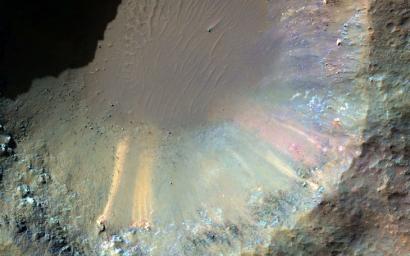
|
A One-Kilometer Crater on the Floor of Saheki Crater
- Click the image above for a larger view
- Full-Res JPEG (2880 x 1800) (691.9 kB)
- Full-Res TIFF (2880 x 1800) (15.6 MB)
Caption:

Map Projected Browse Image
Click on the image for larger version
This HiRISE image shows several smaller craters that formed on the floor of Saheki Crater, an 85-kilometer diameter impact crater north of Hellas Basin.
The western portion of this crater is covered by alluvial fan-like deposits that emanate from channels that cut into the crater rim. This HiRISE image -- indicated by a white box atop of a colorized THEMIS temperature image of Saheki -- was taken just east of the central uplift, where vividly colored materials now lie exposed in a kilometer-sized crater.
An enhanced color infrared image shows a close-up of the 1-kilometer crater and its contents. The wall of the crater shows a rainbow-like array of bedrock and deposits. Much of this material has been eroded over time and has slumped downwards towards the crater floor, leaving behind chalk-like streaks of color. We can also see reddish and dark-toned layered deposits to the south now covered by the crater's green-toned ejecta.
Background Info:
The University of Arizona, Tucson, operates HiRISE, which was built by Ball Aerospace & Technologies Corp., Boulder, Colo. NASA's Jet Propulsion Laboratory, a division of the California Institute of Technology in Pasadena, manages the Mars Reconnaissance Orbiter Project for NASA's Science Mission Directorate, Washington.
Cataloging Keywords:
| Name | Value | Additional Values |
|---|---|---|
| Target | Mars | |
| System | ||
| Target Type | Planet | |
| Mission | Mars Reconnaissance Orbiter (MRO) | |
| Instrument Host | Mars Reconnaissance Orbiter | |
| Host Type | Orbiter | |
| Instrument | High Resolution Imaging Science Experiment (HiRISE) | |
| Detector | ||
| Extra Keywords | Color, Crater, Impact, Infrared, Map | |
| Acquisition Date | ||
| Release Date | 2016-05-04 | |
| Date in Caption | ||
| Image Credit | NASA/JPL-Caltech/Univ. of Arizona | |
| Source | photojournal.jpl.nasa.gov/catalog/PIA20662 | |
| Identifier | PIA20662 | |
